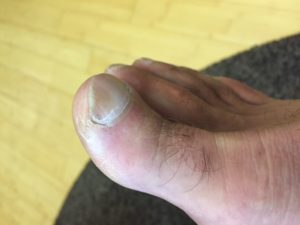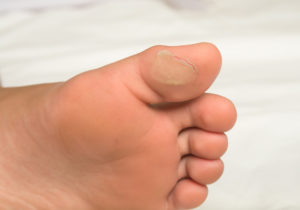Most runners know the dreaded feeling: a hotspot on your foot, whether it’s on your toe, Achilles heel or underfoot.
Blisters can be a kryptonite for runners. Simply put, a blister, or a pocket of skin that’s filled with fluid, is caused by friction. The easy fix? Avoid applying pressure and any additional friction to the area—but we’re runners, so that’s often not a feasible option.
Almost universally, the all-important question is: should I pop the blister or let it be? Ask this question to 500 runners and you’ll likely get a wide array of answers based on personal experience and best practices.

Although one strategy runners employ is letting the blister stay idle, Bianca Charles, the founder of Toronto’s Feet First Clinic, recommends draining a blister, especially if it’s large and susceptible to break on its own if left untouched. A sterile pin or needle should be used for the area to puncture the outer skin, followed by gently draining the fluid from the blister. Finally, thoroughly rinse the area. A bandage can be applied to protect the sore spot. This is especially relevant when the blister is in an awkward spot on your foot.
If the blister is small enough and not at risk of bursting open and possible infection, leaving it be may be your best bet. To avoid this problem all together, consider these tips to prevent blisters from happening in the first place.
Protect your feet
“Protect your feet from blisters by wearing nylon, polyester, or performance socks which are made of ‘moisture-wicking’ materials,” Charles says. “Wearing these types of socks pulls the sweat from the skin of your feet to the surface of the fabric where it dissipates faster.” This is especially true for runners in summer weather or ultra-runners who spend multiple hours at a time on the trails.

Properly-fitted shoes
A common cause of blisters stems from ill-fitted shoes, either too big to allow for unwanted movement within the shoe, or too small, which causes friction between the foot and the shoe’s upper. Either size up or size (or half-size) down or visit your local run-specialty store to get your feet properly measured. Different lacing techniques also relieve pressure on certain parts of your foot and could be just the fix you’re looking for.
Orthotics and insoles
“With the use of custom orthotics, it can be relevant to some blister locations,” Charles says. “This tip is often ignored but offers a big potential on blister prevention. Both orthotics and insoles provide cushioning and comfort. Additionally, insoles can easily replaced.”
Powders and lubrication
“If you want to decrease the friction between your skin rubbing against your shoes, you can apply some petroleum jelly or even powder,” Charles adds. “For lubrication, you can use Vaseline or a generic jelly. On the other hand, you can keep your feet dry by providing talcum powder or even corn starch!”
Alternatively, surgical tape is a cheap alternative that some runners find work for them. Apply the surgical tape in a smooth, single layer on a common hotspot on your foot for added protection.
Blisters are a part of running. But they don’t have to be. Keep your feet safe, people. Toe the line.






 Our Magazine
Our Magazine Previous Release
Previous Release
